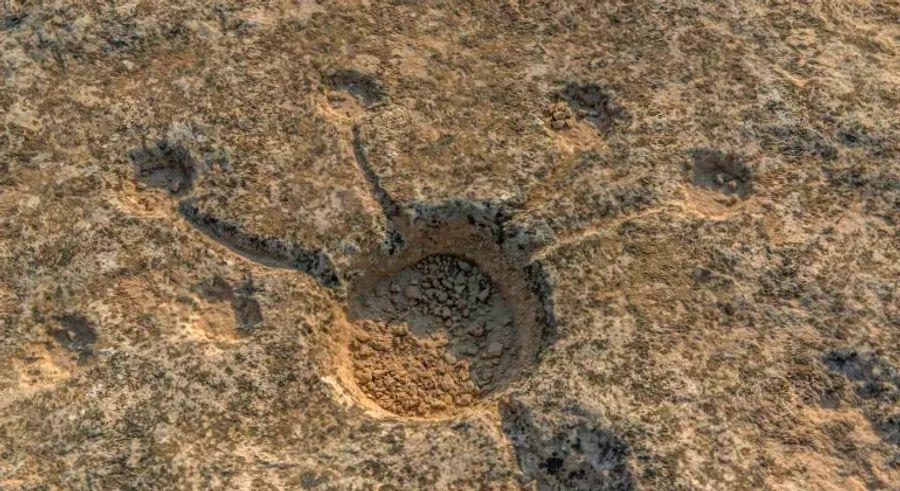The enigmatic carvings in Qatar’s desert

Some markings emerge from the soft rock, resembling sunbathing reptiles, while others form curious depressions that resemble an ancient global board game. A few of the symbols remain completely baffling.
On the rugged, windswept edge of Qatar’s northeastern coast, amidst the sand dunes of the barren desert, lies Al Jassasiya—Qatar’s most significant and expansive rock art site.
Centuries ago, early inhabitants used the low limestone outcrops in this desolate place as canvases, carving symbols, motifs, and representations of objects from their surrounding environment.
Archaeologists have uncovered nearly 900 rock carvings, or petroglyphs, at Al Jassasiya. These carvings predominantly feature mysterious cup marks arranged in patterns such as rows and rosettes, along with striking depictions of sailing ships, both from an aerial view and in profile, among other enigmatic symbols.
“While rock art is common throughout the Arabian Peninsula, some of the carvings at Al Jassasiya are truly one-of-a-kind, with no similar examples found anywhere else,” explained Ferhan Sakal, head of excavation and site management at Qatar Museums, referencing the bird’s-eye view depictions of ships.
“These carvings showcase a remarkable level of creativity and observational skill from the artists who created them,” Sakal noted. “They also demonstrate abstract thinking, as the artists could not have viewed the dhow (traditional boat) from above.”
Cup Marks

Qatar is home to around 12 significant petroglyph sites, mostly situated along the coastline. Interestingly, some carvings can even be found in the heart of Doha’s Al Bidda Park, which overlooks the Corniche, a popular waterfront promenade.
Al Jassasiya, located about an hour north of Qatar’s ultra-modern capital and close to the historic pearling port of Al Huwaila, was first discovered in 1957. A Danish team led by archaeologists Holger Kapel and his son Hans Kapel conducted a detailed study of the site over six weeks in late 1973 and early 1974, documenting the entire location with photographs and drawings.
Of all the figures and compositions cataloged, over a third consist of cup marks in a variety of configurations, shapes, and sizes.
One of the most common patterns found at the site features two parallel rows of seven depressions, leading some researchers to speculate that these may have been used for playing mancala, an ancient board game where players drop small stones into the depressions.
However, some experts challenge this theory, noting that some holes at Al Jassasiya are too small to accommodate mancala stones, while others are situated on slopes – an impractical placement that would cause the stones to fall out.
Other theories suggest that the cup formations could have been used for divination, pearl sorting and storage, or even as a way to measure time and track the tides.
Game theory

So, what purpose did these carvings serve, and what messages do they convey?
“It’s challenging to provide a definitive answer,” Sakal admitted, expressing his own doubts about the board-game theory. “We don’t have any clear indications about the symbols used at Al Jassasiya,” he stated.
“In my view, these markings may have had a ceremonial significance, so ancient that it defies any ethnographic explanation,” he suggested.
But just how ancient are they? “We really don’t know,” Sakal acknowledged, noting the difficulty in dating petroglyphs and rock art in general.
“There are many speculative theories about their age, ranging from the Neolithic era to the late Islamic period,” he added. “Personally, I believe that not all the carvings were made during the same time period.”
A decade ago, a scientific investigation of nine different petroglyphs at Al Jassasiya found no evidence to suggest they were older than a few centuries. However, the researchers concluded that further studies were necessary, including the creation of new methods tailored to limestone carvings.
Although scholars cannot definitively determine when the Al Jassasiya petroglyphs were made or who created them, there is a shared consensus that the most intriguing – and exceptional – carvings at the site are the boat depictions.

These carvings offer valuable insights into the types of boats used in the once-thriving fishing and pearling industries, which have long been the backbone of Qatar’s economy, as well as the distinctive features of the vessels.
Most of the boats depicted from a bird’s-eye view appear fish-shaped, with sharp sterns and rows of oars, etched with a pointed metal instrument.
The carvings include various details, such as intersecting ribs and holes, which are believed to represent the placement of masts and thwarts.
In some instances, a long line extends from the stern, representing a rope that ends in either a traditional Arabic anchor (a triangular stone with two holes) or a European-style anchor (a metal one with a long shaft and two curved arms, used in the region around seven centuries ago).
Journey to the afterlife

According to Frances Gillespie and Faisal Abdulla Al-Naimi in their work 'Hidden in the Sands: Uncovering Qatar’s Past,' some of the boats feature oars that are not aligned in the typical parallel fashion, as one would expect for rowing. Instead, the oars point in various directions.
'This is how the boats would have appeared when anchored on the pearl banks, with oars left in place for the divers to hold onto and rest after each dive,' they explain.
Experts can only speculate about the reasons behind the unusually high concentration of ship carvings at Al Jassasiya compared to other coastal petroglyph sites in Qatar.
Gillespie and Al-Naimi suggest that 'ships held a profound symbolic significance for ancient cultures, serving as vessels to carry the deceased from this world to the next.'
'Both the Babylonians and the ancient Egyptians believed that the dead crossed into the afterlife by ship. In Greek mythology, the ferryman Charon transported souls across the Styx to the underworld. These ship carvings may echo ancient beliefs and folk memories stretching back to prehistory,' they theorize.
No matter the reason behind the carvings, visitors are advised to bring water, wear a hat, and apply sunscreen while exploring the site and reflecting on its mysterious symbols.
Since the site is fenced off and lacks shaded spots, it's best to visit either at sunrise or sunset. Al Jassasiya is conveniently located just south of the popular Azerbaijani Beach, making it easy to combine a visit with a relaxing day by the sea.
Evaluation :
5/5



